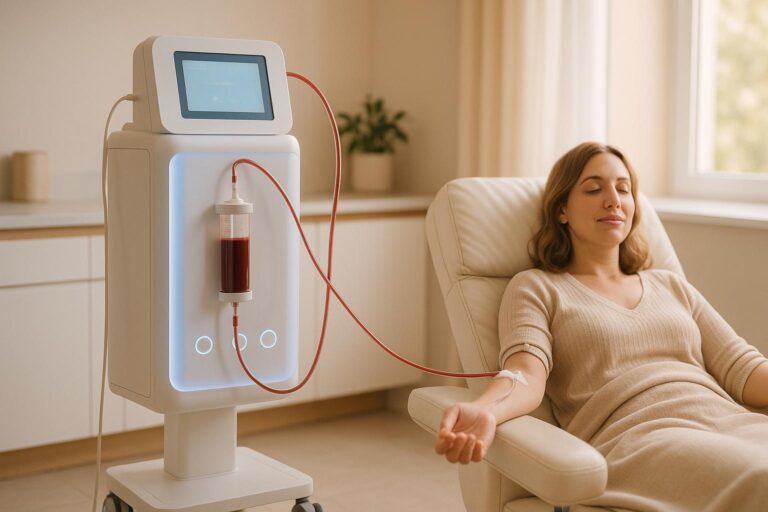Diurnal cortisol curves show how your cortisol levels naturally rise and fall throughout the day, following your body’s internal clock. Typically, cortisol peaks in the morning to help you wake up, gradually decreases throughout the day, and reaches its lowest at night to support restful sleep.
When these patterns are disrupted, it can impact energy, stress management, immune health, and even sleep quality. Flattened, reversed, or consistently high cortisol levels often signal underlying issues like chronic stress, adrenal dysfunction, or lifestyle factors such as poor sleep or diet.
Testing cortisol levels at different times of the day, especially through saliva tests, can help identify these disruptions. This information is vital for creating targeted health strategies, including stress management, dietary adjustments, and potential medical interventions.
How Cortisol Works in the Body
How the HPA Axis Controls Cortisol
The hypothalamic-pituitary-adrenal (HPA) axis is the system responsible for managing cortisol production, and it operates through a coordinated effort between three key components.
It all begins in the hypothalamus, a small but powerful part of the brain that serves as the body’s command center. When the hypothalamus detects stress – whether it’s physical, emotional, or environmental – it releases a hormone called corticotropin-releasing hormone (CRH). This hormone travels to the pituitary gland, located just beneath the brain, prompting it to release adrenocorticotropic hormone (ACTH) into the bloodstream.
Next, ACTH makes its way to the adrenal glands, which sit atop your kidneys. The outer layer of these glands, known as the adrenal cortex, responds to ACTH by producing cortisol. This process kicks into gear within minutes.
What keeps this system in check is its built-in feedback loop. As cortisol levels rise in the bloodstream, they signal the hypothalamus and pituitary gland to slow down hormone production. This negative feedback mechanism ensures cortisol doesn’t remain elevated for too long, maintaining balance in the body.
Interestingly, the HPA axis doesn’t just respond to immediate stress – it also aligns with your body’s natural rhythms. Light exposure plays a role in synchronizing cortisol release, which is why cortisol levels naturally peak in the morning and decrease by nighttime. This system supports both quick stress responses and the daily cortisol surge known as the CAR.
The Cortisol Awakening Response (CAR)
The Cortisol Awakening Response (CAR) is a key indicator of adrenal health. Within the first 30 to 45 minutes after waking up, cortisol levels rise sharply – by as much as 50% to 75% compared to nighttime levels. This surge helps your body transition from sleep to wakefulness.
This morning spike happens whether you wake up to an alarm or naturally. The CAR plays an important role in getting your day started, as it mobilizes glucose for energy, slightly raises blood pressure, and sharpens mental focus.
Timing is everything when it comes to the CAR. Ideally, the response begins within 15 minutes of waking and peaks between 30 and 45 minutes later. After reaching this peak, cortisol levels should gradually decline throughout the day. Healthy adrenal function typically results in cortisol dropping by about 10% to 15% every few hours after the morning high.
When the CAR doesn’t function properly, it can reveal underlying issues. A blunted or absent CAR often points to adrenal dysfunction, which can cause morning fatigue, brain fog, or trouble getting out of bed. On the flip side, an excessive CAR – when cortisol spikes too high or stays elevated too long – can lead to feelings of morning anxiety, jitteriness, or being "wired but tired."
The CAR also sheds light on how well someone handles stress. A strong morning cortisol response is often seen in individuals with good stress resilience, while chronic stress or burnout can weaken this response over time. These changes can disrupt overall cortisol rhythms, leading to further complications.
What Affects Cortisol Rhythms
Several lifestyle and health factors can disrupt cortisol patterns, which helps explain why cortisol testing results vary so much between individuals.
- Sleep quality and schedule: Poor sleep, irregular schedules, or shift work can throw cortisol rhythms off balance. Jet lag or late nights can delay the morning peak and elevate cortisol levels in the evening.
- Chronic stress: Prolonged stress initially keeps cortisol levels high throughout the day. Over time, this constant demand can wear down the adrenal glands, leading to lower cortisol production and flattened daily patterns.
- Light exposure: Bright light, especially blue light from screens, can delay the natural nighttime drop in cortisol by suppressing melatonin. On the other hand, insufficient morning light can weaken the CAR.
- Physical factors: Strenuous exercise late in the day can elevate cortisol for hours. Blood sugar imbalances, like hypoglycemia, trigger cortisol to restore glucose levels. Inflammation from infections or autoimmune conditions also disrupts cortisol rhythms.
- Medications: Drugs like corticosteroids, some antidepressants, birth control pills, and even over-the-counter pain relievers can influence cortisol production and metabolism.
- Age and hormonal changes: Cortisol levels tend to rise slightly with age, though daily fluctuations may become less pronounced. Women may notice changes in cortisol patterns during menstrual cycles, pregnancy, or menopause due to interactions with reproductive hormones.
- Nutrition: Deficiencies in nutrients like vitamin C, B vitamins, magnesium, and omega-3s can impair adrenal health. Excessive caffeine, especially later in the day, can also raise cortisol levels and interfere with natural rhythms.
Understanding these factors can provide valuable insight into how to maintain healthy cortisol levels and address disruptions effectively.
DUTCH Webinar: The Importance of Measuring Diurnal Cortisol

How to Test Diurnal Cortisol
Getting an accurate picture of cortisol levels throughout the day is essential for understanding diurnal rhythms and planning effective adrenal health interventions.
Salivary Cortisol Testing
Salivary cortisol testing is one of the most effective ways to track how cortisol fluctuates throughout the day. Unlike blood tests, which capture cortisol levels at a single moment, saliva testing allows for a broader view of the hormone’s daily rhythm.
Patients collect saliva samples at specific times: immediately upon waking, 30 minutes after waking, in the late afternoon, and right before bed. This schedule provides a detailed look at the cortisol curve, including its natural drop-off in the evening.
One of the key benefits of saliva testing is that it measures free, bioavailable cortisol – the active form of the hormone. Since samples are collected in everyday environments rather than clinical settings, the results tend to reflect a more accurate representation of a person’s daily hormone patterns.
Most functional medicine practitioners recommend testing protocols with multiple collection points. This approach ensures subtle changes in cortisol levels aren’t missed, which can be critical for diagnosis and treatment. However, following the collection instructions carefully is vital for obtaining reliable results.
Testing Best Practices for Accurate Results
To get the most reliable cortisol test results, preparation and timing are everything. The first sample should be taken immediately upon waking, before doing anything that could alter cortisol levels. Setting an alarm or using reminders can help ensure the next samples are collected at the correct intervals.
Certain activities can skew the results, so it’s important to avoid them. For instance, brushing or flossing before collecting a sample can cause minor oral bleeding, which might contaminate the saliva. Additionally, patients should consult with their healthcare provider about any medications or hormonal treatments they’re using, as these can influence cortisol readings.
Stress levels on the testing day also play a big role. Acute stress – whether emotional or physical – can temporarily spike cortisol levels and disrupt the overall pattern. For those with irregular schedules, such as shift workers, testing protocols may need to be adjusted to account for their unique routines.
Lastly, proper handling of the samples is crucial. Follow the testing guidelines to collect the correct amount, and make sure samples are stored and shipped as instructed to maintain their integrity. Recording details like wake-up times, stressors, and any medication changes can provide helpful context for interpreting the results accurately.
Reading and Understanding Cortisol Test Results
Once you’ve gone through diurnal cortisol testing, the next step is making sense of your results. These results provide insight into your adrenal function and can help pinpoint imbalances that may require attention. By analyzing cortisol patterns, healthcare providers can make informed decisions about treatment and identify potential adrenal dysfunction.
Normal Cortisol Curve Patterns
Under normal conditions, cortisol levels follow a predictable daily rhythm. They peak in the morning at 13–24 ng/mL, surging by 50–75% within 30 minutes of waking. This is known as the cortisol awakening response (CAR), a strong indicator of a well-functioning hypothalamic-pituitary-adrenal (HPA) axis.
As the day progresses, cortisol levels gradually decline. By late afternoon, levels typically fall within the range of 5 to 10 ng/mL. This steady decrease helps the body transition from daytime activity to evening relaxation.
By bedtime, cortisol levels hit their lowest point, usually between 1 and 4 ng/mL. This drop signals the body to prepare for sleep, allowing melatonin production to rise. Low nighttime cortisol is crucial for restorative sleep and proper recovery.
When graphed, this daily rhythm resembles a "ski slope" – starting high in the morning and tapering off smoothly throughout the day. This pattern supports energy regulation, sleep cycles, and overall metabolic health. Any deviations from this rhythm can indicate underlying health concerns.
Abnormal Patterns and Health Problems
When cortisol levels stray from their normal rhythm, it often points to underlying health issues. Identifying these abnormal patterns is essential for diagnosing and treating specific conditions.
Flattened Cortisol Curves
This pattern features low morning cortisol levels that remain relatively flat throughout the day. It’s commonly associated with chronic fatigue and afternoon energy crashes. Flattened curves often develop after prolonged stress, leaving the adrenal glands less responsive over time.
Reversed Cortisol Rhythms
In this case, cortisol levels are low during the day but rise in the evening or at night. This reversal can cause daytime sluggishness and nighttime restlessness, often described as feeling "wired but tired." Shift workers or individuals under chronic stress frequently experience this pattern.
Consistently High Cortisol
Elevated cortisol levels throughout the day indicate a body stuck in a chronic stress response. Morning levels may exceed the normal range, and the usual evening decline doesn’t occur. Symptoms include anxiety, trouble relaxing, and disrupted sleep.
Midday Cortisol Spikes
Instead of a gradual decline, cortisol unexpectedly spikes in the afternoon. This irregularity can lead to anxiety and energy crashes later in the day. Common triggers include blood sugar imbalances, caffeine sensitivity, or stress-induced cortisol release.
Here’s a quick comparison of normal and abnormal cortisol patterns:
| Pattern Type | Morning Levels | Evening Levels | Common Symptoms | Associated Conditions |
|---|---|---|---|---|
| Normal | 13–24 ng/mL | 1–4 ng/mL | Steady energy, good sleep | Healthy adrenal function |
| Flattened | 8–15 ng/mL | 3–8 ng/mL | Chronic fatigue, crashes | Adrenal fatigue, burnout |
| Reversed | 5–12 ng/mL | 8–20 ng/mL | Wired but tired, insomnia | Chronic stress, shift work |
| Consistently High | 25+ ng/mL | 8+ ng/mL | Anxiety, poor relaxation | Cushing’s syndrome, stress |
| Midday Spikes | Variable | Variable | Anxiety, energy swings | Blood sugar issues, caffeine sensitivity |
Abnormal cortisol rhythms don’t just affect energy levels – they can disrupt multiple body systems. For instance, immune function often takes a hit, making you more prone to infections and slower to heal. Digestive issues can also arise, as cortisol imbalances may reduce stomach acid production and upset gut bacteria.
Metabolic health is another area of concern. Irregular cortisol patterns can make it harder to maintain stable blood sugar levels and manage weight. Many people with these disruptions experience cravings for sugar or caffeine, as their bodies try to compensate for energy dips.
Mental health and cognitive performance are particularly vulnerable to cortisol imbalances. Flattened or reversed patterns are often linked to depression, anxiety, brain fog, and trouble focusing. Proper cortisol rhythms are essential for supporting neurotransmitter production and maintaining mental clarity.
sbb-itb-d9e542d
Using Cortisol Testing in Functional Medicine
Functional medicine uses detailed cortisol testing to develop targeted strategies aimed at restoring the body’s natural rhythms. By examining the full cortisol curve, practitioners can identify specific dysfunctions and create personalized treatment plans.
Creating Treatment Plans from Cortisol Data
Analyzing the cortisol curve provides a clear guide for designing treatments tailored to an individual’s unique patterns. For flattened cortisol patterns, the focus is on adrenal recovery. This often involves adaptogenic herbs like ashwagandha and rhodiola, nutritional support such as B-vitamins, vitamin C, and magnesium, and lifestyle changes like stress management, gentle exercise, and consistent sleep routines to help reset circadian rhythms.
For reversed cortisol patterns – where cortisol is high at night and low in the morning – treatment emphasizes calming evening cortisol levels while boosting morning levels. This may include phosphatidylserine supplements to lower nighttime cortisol. Evening relaxation techniques such as meditation, warm baths, or gentle stretching, combined with morning light exposure, help reinforce natural circadian cues and improve sleep-wake cycles.
When cortisol levels remain consistently high, the goal is to calm an overactive stress response. This requires identifying and addressing stressors, whether they are psychological, physical, or environmental. Interventions might include cognitive behavioral therapy, massage, or acupuncture to relax the nervous system. Dietary changes, such as reducing caffeine and sugar while incorporating anti-inflammatory foods, further support this process.
Midday cortisol spikes often point to blood sugar instability or specific daytime stress triggers. These cases are managed by balancing meal timing, increasing protein intake, and closely monitoring blood sugar levels.
In some cases, hormone replacement therapy is considered, especially when cortisol imbalances disrupt other hormonal systems. For instance, low cortisol can suppress thyroid function, while high cortisol may interfere with reproductive hormones. Bioidentical hormone therapy can help restore balance across these interconnected systems.
The timeline for improvement varies depending on the severity and duration of the imbalance. Acute disruptions may show progress within weeks, while chronic patterns often require months of consistent care. Functional medicine clinics integrate these strategies into individualized treatment plans, aiming for comprehensive recovery.
Kinnection Clinic‘s Approach to Adrenal Health

Kinnection Clinic takes a comprehensive approach to adrenal health, combining advanced diagnostics and multi-faceted treatments to restore balance. Diurnal cortisol testing is central to their functional medicine model, as adrenal health impacts nearly every aspect of wellness. Dr. Lars Gunnar and his team go beyond cortisol curve analysis, incorporating thyroid panels, nutrient assessments, and inflammatory markers to uncover the root causes of hormonal imbalances.
The clinic’s treatment plans blend various therapies for optimal results. Nutrition plans tailored to adrenal recovery are a key component, while IV therapy delivers high-dose nutrients like vitamin C, B-complex vitamins, and magnesium directly into the bloodstream, bypassing common absorption issues.
For patients whose cortisol imbalances affect other hormonal systems, the clinic offers bioidentical hormone therapy to restore balance to thyroid, reproductive, and growth hormones. They also utilize peptide therapy, a cutting-edge regenerative medicine treatment designed to promote natural cortisol rhythms and support tissue repair at the cellular level.
What makes Kinnection Clinic stand out is its integration of performance coaching and mindset training alongside medical treatments. Stress management is critical for cortisol balance, so their coaches help patients develop sustainable strategies for reducing stress, improving sleep habits, and building emotional resilience.
The clinic’s commitment to family wellness ensures that adrenal health is addressed across all age groups. From pediatric care to prenatal support, they monitor and manage cortisol levels at every life stage, recognizing its broad impact.
Progress is carefully tracked with follow-up testing every three to four months. This allows the clinic to adjust treatment plans based on each patient’s response, ensuring a personalized and evolving approach to restoring adrenal health over the long term.
Key Points About Diurnal Cortisol Curves
Diurnal cortisol rhythms play a crucial role in overall health, and disruptions in these patterns have been linked to serious conditions like cardiovascular disease, stroke, diabetes, depression, and even reduced lifespan. These daily fluctuations not only reflect your general well-being but also provide a window into precise diagnostic possibilities.
The diurnal cortisol curve is a powerful diagnostic tool that helps assess how well your adrenal glands and stress response systems are functioning. A normal curve indicates that these systems are working as they should, maintaining balance and resilience.
However, cortisol patterns are complex, and a single measurement might not reveal underlying issues. That’s why expert interpretation of these results is so important.
Beyond diagnosis, diurnal cortisol testing serves as a foundation for creating tailored treatment plans. By understanding your unique cortisol patterns, healthcare providers can design therapies that address your specific needs – an approach central to functional medicine, which emphasizes personalized care and targeted interventions.
FAQs
How can I tell if my cortisol levels are off, and what steps should I take if they are?
Abnormal cortisol levels can manifest in various ways, including unexplained weight changes, ongoing fatigue, or sudden mood swings. However, the only reliable way to determine if cortisol levels are off is through specific tests. These tests, which use blood, urine, or saliva samples, track how cortisol fluctuates during the day.
If testing reveals irregular levels, it’s crucial to seek guidance from a healthcare professional. They can pinpoint the underlying cause and suggest treatments tailored to your needs. This might involve adjustments to your daily routine, stress-reduction strategies, or hormone therapy to bring your cortisol levels back into balance and support your overall health.
What can I do to support a healthy cortisol rhythm and improve adrenal health?
To keep your cortisol levels in check and support adrenal health, aim for a balanced lifestyle that reduces stress. Start by prioritizing quality sleep – stick to a regular bedtime routine and cut back on screen time before hitting the pillow. Adding regular physical activity into your day, like walking, yoga, or strength training, can also help regulate cortisol levels.
Your diet plays a big role too. Focus on an anti-inflammatory approach by eating plenty of whole, nutrient-packed foods, including fresh fruits, vegetables, lean proteins, healthy fats, and whole grains. Try to limit caffeine and sugar, and stay well-hydrated throughout the day. On top of that, practice stress-management techniques like mindfulness, deep breathing, or meditation to keep your emotional health in check and support your adrenal glands.
Simple adjustments like these can help bring your cortisol rhythm back into balance and boost your overall energy.
What is the Cortisol Awakening Response (CAR), and how does it impact my energy and stress levels?
Cortisol Awakening Response (CAR)
The Cortisol Awakening Response (CAR) refers to the natural surge in cortisol levels that happens within the first 30 minutes of waking up. This spike is like your body’s morning boost, giving you the energy and alertness needed to kick-start your day. For most people, cortisol levels increase by 38% to 75% during this window, setting the stage for how well you’ll perform – physically and mentally – throughout the day.
A well-functioning CAR is also tied to better stress management. It equips your body to handle daily challenges more efficiently. However, when this response is weakened or flattened – often due to chronic stress – you may experience fatigue, trouble concentrating, and a reduced ability to cope with stress. Keeping your cortisol levels balanced is key to maintaining steady energy, sharper focus, and overall wellness.



